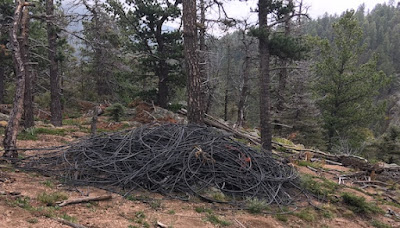 |
Firs have been cut or limbed to allow more sunlight on the grow site. Drip irrigation lines fed
the individual plants. Given the thin, poor mountain soil, heavy amounts of fertilizers are used. |
On an untypically (but helpfully) foggy May morning in the Wet Mountains of southern Colorado, two camouflaged US Forest service agents, armed with pistols and an AR-15 rifle, scouted up a ridge.
They reached their target area, a placed used by Mexican cartel* marijuana growers for several years,
armed growers who had been arrested the previous October.
Finding no one re-using the site, they marked the faint footpath up from State Highway 165 with orange flagging and notified another agent waiting at the Forest Service work center in San Isabel.
 |
| BHA volunteer and trash. |
Before long, the other agent hiked in too, accompanied by a dozen members of
Backcountry Hunters & Anglers, a conservation group with a de-centralized, "boots on the ground" approach to issues.
We all set to work — stuffing abandoned sleeping bags with trash, tearing down the crude buildings made of fir saplings and baling wire (kitchen, sleeping quarters, drying shed), and pulling armloads of black plastic pipe from under the forest duff and fallen trees.
With the plants gone, shelters gone, and the irrigation system gone, maybe this site would be less attractive in the future. Maybe the word would go back to Michoacán:
Virgilio and Erik are doing time in an American prison. Maybe.
 |
| Interior of the kitchen area. White plastic buckets are camouflaged with paint. |
Some people will say, "The growers arrested were just low-level 'grunts.' Why bother with them?" Low-level or not, they still do bad things, all of which I saw signs of or was informed about.
 |
It takes a little time to free a tree
from wraps of wire. |
• Putting pesticides and insecticides into the watershed (I saw containers)
• Diverting water illegally
• Cutting and injuring trees illegally
•
Killing animals (deer, bear, etc.) illegally
• Potentially posing a threat to other public-lands visitors in order to hide their activities
I don't want any of that in your/my/our national forest, period full stop.
In 2012, I supported
Amendment 64, which legalized recreational cannabis and limited home growing. I have joined the multitudes using
CBD products for health support.
But passing Amendment 64 did indeed attract people who thought that they could grow outside the regulatory frameworks and somehow not be noticed.
Some were from inside the USA (mostly from Miami, curiously enough). They tended to buy or rent houses, stuff them with plants, and then be caught when (surprise) the utility company tipped off law enforcement that the split-level house at 428 Comanche Drive** was using fifteen times as much electricity as its neighbors. Others grew on private land, sometimes combining a legal operation with an additional illegal one.
 |
| Some of the collected irrigation pipes and drip tubes. |
|
To generalize, the public-lands growers tend to be Mexicans. Maybe it's a rural-tradition thing, to spend your summer in a
jacalito
held together with twine and baling wire. Preferred locations are away
from developed recreation sites, have a tiny stream that can be
diverted, and a south-facing slope for light and warmth. Yet from the
site we cleaned, we could see and hear the state highway, not more than
half a mile away — they don't want to carry those propane tanks
and coils of plastic pipe and batteries and supplies and trays of clones
too far.***
Compared to what legal growers produce, it seems like a lot of risky
work for a lesser product, but there's the rub: some people don't want
to pay legal retail prices. (California in particular, according to some,
is keeping the black market alive by over-taxing legal cannabis.) Or
they can sell it outside Colorado.
Finally, all the pipe and trash was collected in the most-open area, where a National Guard helicopters will be able to lift it out.
 |
Helicopter lifting bundled trash from a different grow site
(US Attorney's Office). |
* Law-enforcement officers and prosecutors avoid the word "cartel" in public statements. In private, they use it. After all, if groups of men, mostly from Michoacán, are caught hundreds of miles from home, with someone planning the grow sites, supporting them logistically, and moving the product, that all suggests an organization, not a bunch of freelance growers.
** Fictional address.
***Some bright person should have (or has) created a GIS overlay to identify potential grow sites, just like wildlife habitats.















